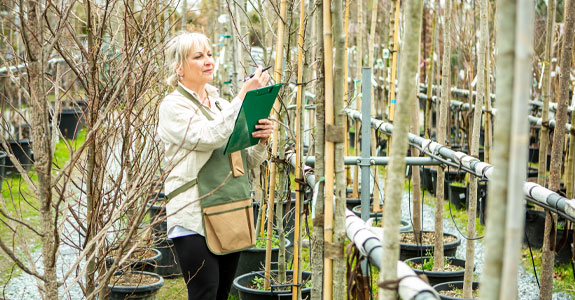Insurance for nurseries: Your ultimate guide

Protecting your nursery benefits your employees, your customers, your community, and your bottom line. One way to do that is to choose business insurance that aligns with your risk exposures.
This guide can get you the answers you need so you can move forward focusing on what matters most—raising plants, shrubs, and beautiful ornamentals that influence the health and well-being of the community around you.
Nursery risk factors
To determine coverages that make sense for your nursery, you first need to recognize the unique risk factors your business faces, such as:
Crop losses
Your plants, trees, and vulnerable stock could be put in jeopardy with damage from equipment breakdown, severe weather, or pests. Crop insurance can help protect your losses, and can even protect your future crop income if you have a missed crop cycle and can’t plant due to damage.
Equipment and tools
Your equipment and tools, like grow lights and seed bed warmers, are vital for your nursery operations. If they break down, you could lose weeks of productivity and revenue. Equipment breakdown coverage can help reduce your repair and replacement costs and get your operations back on track.
Jobsite risks
Hazards such as uneven ground, slippery spots from water, or poorly managed parking lots and sidewalks, can lead to costly injuries. Your insurance provider can work with you to help identify possible problem areas or create a safety plan for your business.
Theft
Equipment and cash theft—whether by external thieves or dishonest employees—is a common source of losses at nurseries. You might think you’ve protected your equipment, but thieves are resourceful. If they do manage to steal something, insurance can help you cover the cost of a replacement.
Storm damage
You’re in the type of business that continuously faces the threat of hail, lightning, high winds, and tornadoes. Depending on where you’re located, there may also be hurricanes and snowstorms. Significant storm damage repairs can be expensive and delay how quickly you can get your business up and running again. Property insurance can help protect you and minimize your losses when storm damage affects your operation.
Nursery insurance coverage options
Broadly speaking, the types of business insurance coverage you’ll purchase for your nursery can be divided into three categories:
Property insurance coverage can help protect your buildings, equipment, supplies, and tools.
Commercial auto coverage can help cover losses related to accidents that happen when you're using a vehicle for your business.
Liability insurance coverage includes general liability, umbrella liability, and workers’ compensation and can help protect you and your business if accidents occur.
Commercial property insurance
You can customize your commercial property insurance based on specific risk exposures you face—whether it’s from fire, storm damage, theft, or equipment breakdowns. If a storm knocks out a ceiling panel and causes water damage and inventory loss, your property insurance can help cover the damage to your structure. It can even help protect your future income if you can’t plant your next crop due to damage.
Commercial auto insurance
Along with growing your inventory, you likely also need to transport and deliver it. Nursery transport vehicles can be heavy and difficult to drive, heightening accident risk. Commercial auto insurance can help cover you if there’s an auto accident when you or your employees drive for business purposes.
General liability insurance
A general liability insurance policy covers losses to non-employees caused by your services, business operations, or employees. For example, if you mistakenly label an apple tree as a pear tree and your customer spends money and time to grow it and as it grows and produces fruit they see it’s not the tree they were supposed to get, you can be held liable for the financial expenses and the time spent on growing the wrong tree. General liability insurance could help cover your legal bills and any compensation.
Umbrella liability insurance
While most claims are covered by your general liability insurance policy, certain incidents or lawsuits may be so severe they deplete the limits of your main coverage. Umbrella liability coverage provides an extra layer of coverage that can help protect your business in the event of a catastrophic liability loss or a large judgment against you or your company.
Workers’ compensation
Depending on the number of employees you have, workers’ compensation insurance may be required in your state. This insurance can help protect you against liability from a work-related accident, including injuries, illnesses, disabilities, and death. It also helps your employees with medical expenses, wage replacement, and other covered benefits after illness or injury.
Nursery insurance providers
It’s best practice to work with an insurance provider who understands the specialties of your industry—and can provide customized coverages and safety services to help protect you and your employees.
Hortica®, a brand of the Sentry Insurance Group, has been recognized within the horticultural industry for more than 135 years. The Hortica team has a deep understanding of the horticultural environment, its risks, and how they affect your industry. That knowledge also helps us customize your coverage options and risk management opportunities.
If you have any questions about insuring your plant nursery business or would like to review your current policy, contact us today or request a quote.
Related links:
Learn how taking a proactive safety approach can help improve your business operations and your bottom line.
Understand the steps and what to expect during a safety visit from your insurance provider.
Your business insurance policy should evolve as your operations and risks change. Use our insurance renewal checklist to analyze where your business has changed.
The information in this article is for informational or entertainment purposes only. View our disclaimer by going to terms and conditions and clicking on Learning Center disclaimer in the table of contents.
